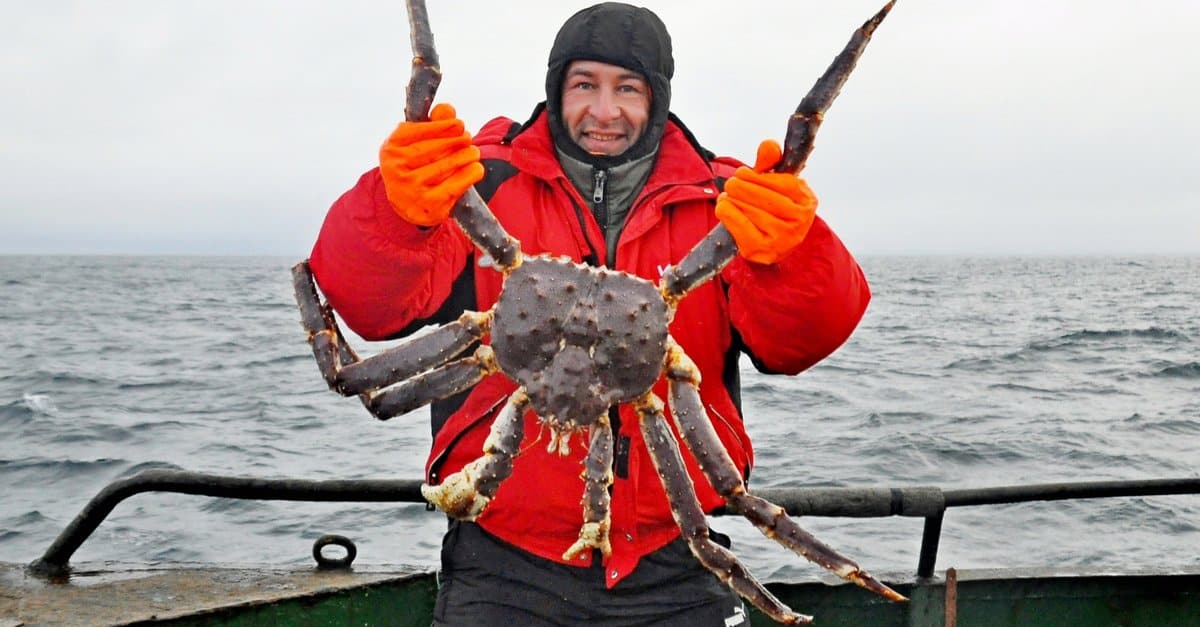There are sea creatures, and then there are legends. If you’ve ever laid eyes on an Alaskan King Crab, you know exactly what we’re talking about. These aren’t your average shore-dwelling crustaceans; they are the true titans of the deep, a creature so magnificent it seems almost mythical. And if you’ve ever seen one up close, like the behemoth in our image above, you’ll understand why these crabs command such awe and respect.
But how big can Alaskan King Crabs actually get? The one pictured here is certainly impressive, showcasing a staggering leg span that dwarfs the person holding it. While individual sizes vary, mature red king crabs (the most commercially sought-after species among Alaskan king crabs) can boast a leg span of up to 5 feet and weigh over 20 pounds! Imagine the sheer power and presence of a creature that large scuttling across the ocean floor.
These aren’t just big crabs; they are a cornerstone of a fascinating and often dangerous industry. The waters of Alaska, particularly the Bering Sea, are home to these magnificent creatures, but harvesting them is no easy feat. The fishing season is short, the conditions are brutal, and the stakes are incredibly high. Fishermen brave treacherous storms, icy decks, and the constant threat of a rogue wave, all in pursuit of this prized delicacy. It’s a testament to human courage and resilience, mirroring the hardy nature of the crabs themselves.

Beyond their impressive size and the thrill of the hunt, Alaskan King Crabs are a culinary marvel. Their sweet, rich meat is unlike any other seafood. Whether steamed, grilled, or simply served with drawn butter, the flavor is unparalleled. It’s a taste of the wild, a luxurious indulgence that transports you to the icy, pristine waters from which it came. This exquisite flavor profile is what drives the demand, making it one of the most sought-after seafood items globally.
But let’s dive a little deeper into what makes these creatures so unique. The term “Alaskan King Crab” actually refers to several species, with the Red King Crab (Paralithodes camtschaticus) being the most common and largest, followed by the Blue King Crab (Paralithodes platypus) and the Golden King Crab (Lithodes aequispinus). Each has its own distinct characteristics, but all share that impressive, spiky carapace and long, powerful legs. Their exoskeleton, a formidable armor, protects them from predators in the harsh deep-sea environment.

Their life cycle is equally intriguing. Female crabs can carry hundreds of thousands of eggs, and the journey from a tiny larva to a mature, colossal crab is a perilous one. They undergo multiple molts, shedding their old shells to grow larger, a vulnerable period where they seek shelter until their new shell hardens. This slow growth contributes to their impressive size and the value of a mature crab.
The ecological balance of their habitat is crucial. Sustainable fishing practices are paramount to ensure the continued health of the Alaskan King Crab population. Strict regulations, including quotas and size limits, are in place to protect these valuable creatures and their delicate ecosystem. It’s a fine balance between meeting consumer demand and preserving a vital marine species for future generations.
So, the next time you see an Alaskan King Crab, whether in a picture, on a menu, or, if you’re lucky, in person, remember the incredible journey it has taken. From the depths of the icy Alaskan waters to your plate, it represents a remarkable story of nature’s grandeur, human endeavor, and a culinary experience like no other. It’s more than just a crab; it’s a symbol of the wild, untamed beauty of our oceans.


